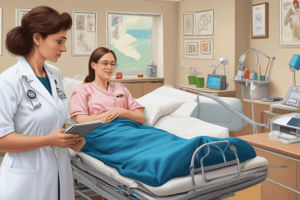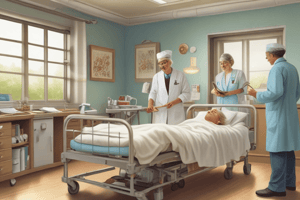Podcast
Questions and Answers
What is the primary goal of patient education?
What is the primary goal of patient education?
- To promote health maintenance and prevention of illness (correct)
- To help patients cope with impaired functions
- To restore health in patients with chronic illnesses
- To educate patients about their diagnosis
What is the role of the nurse in teaching and learning?
What is the role of the nurse in teaching and learning?
- To provide education to patients only on their diagnosis
- To provide emotional support to patients
- To provide education to patients' families
- To provide education to all patients as part of their legal responsibilities (correct)
What is teaching in the context of patient education?
What is teaching in the context of patient education?
- Imparting knowledge through a series of directed activities (correct)
- Developing treatment plans for patients
- Providing emotional support to patients
- The process of understanding and applying newly acquired concepts
What is the process of understanding and applying newly acquired concepts?
What is the process of understanding and applying newly acquired concepts?
What is effective communication in teaching and learning?
What is effective communication in teaching and learning?
What is a purpose of patient education?
What is a purpose of patient education?
What is the primary purpose of cognitive learning in patient education?
What is the primary purpose of cognitive learning in patient education?
Which basic learning principle is most closely related to a patient's ability to learn?
Which basic learning principle is most closely related to a patient's ability to learn?
What is the main advantage of patient education in clinic, home care, and rehabilitation settings?
What is the main advantage of patient education in clinic, home care, and rehabilitation settings?
What is a key factor in clinical judgment in patient education in an acute care setting?
What is a key factor in clinical judgment in patient education in an acute care setting?
Which of the following is NOT a domain of learning?
Which of the following is NOT a domain of learning?
What is the primary role of a nurse's knowledge of a patient's health condition in clinical judgment in patient education?
What is the primary role of a nurse's knowledge of a patient's health condition in clinical judgment in patient education?
What is the primary focus of the assessment phase in the nursing process?
What is the primary focus of the assessment phase in the nursing process?
What is the main purpose of setting priorities in the planning phase of the nursing process?
What is the main purpose of setting priorities in the planning phase of the nursing process?
Which teaching approach is most effective in promoting patient participation and engagement?
Which teaching approach is most effective in promoting patient participation and engagement?
What is the primary benefit of using analogies in patient education?
What is the primary benefit of using analogies in patient education?
Why is it essential to consider cultural diversity in patient education?
Why is it essential to consider cultural diversity in patient education?
What is the primary purpose of the teach-back method in patient education?
What is the primary purpose of the teach-back method in patient education?
How can nurses adapt patient education to accommodate patients with special needs, such as illiteracy or disabilities?
How can nurses adapt patient education to accommodate patients with special needs, such as illiteracy or disabilities?
What is the ultimate goal of the evaluation phase in the nursing process?
What is the ultimate goal of the evaluation phase in the nursing process?
What is the primary outcome of patient education in relation to health?
What is the primary outcome of patient education in relation to health?
What is the key aspect of effective communication in teaching and learning?
What is the key aspect of effective communication in teaching and learning?
What is the primary focus of teaching in patient education?
What is the primary focus of teaching in patient education?
What is the primary responsibility of nurses in relation to patient education?
What is the primary responsibility of nurses in relation to patient education?
What is the primary outcome of patient education in relation to illness prevention?
What is the primary outcome of patient education in relation to illness prevention?
What is the primary relationship between learning and teaching in patient education?
What is the primary relationship between learning and teaching in patient education?
What is the primary factor that influences a patient's ability to learn?
What is the primary factor that influences a patient's ability to learn?
Which of the following settings provides the most opportunity for comprehensive ongoing education?
Which of the following settings provides the most opportunity for comprehensive ongoing education?
What is the primary role of a nurse's knowledge of a patient's health condition in patient education?
What is the primary role of a nurse's knowledge of a patient's health condition in patient education?
What is the primary focus of clinical judgment in patient education?
What is the primary focus of clinical judgment in patient education?
Which of the following is a key factor in the ability to learn?
Which of the following is a key factor in the ability to learn?
What is the primary benefit of identifying a patient's resources early in instruction?
What is the primary benefit of identifying a patient's resources early in instruction?
What is the primary focus of the nurse during the assessment phase of the nursing process in patient education?
What is the primary focus of the nurse during the assessment phase of the nursing process in patient education?
Which of the following instructional methods is most suitable for patients with low literacy levels?
Which of the following instructional methods is most suitable for patients with low literacy levels?
What is the primary purpose of setting priorities in the planning phase of the nursing process in patient education?
What is the primary purpose of setting priorities in the planning phase of the nursing process in patient education?
Which of the following teaching approaches is most effective in promoting patient participation and engagement?
Which of the following teaching approaches is most effective in promoting patient participation and engagement?
What is the primary benefit of using analogies in patient education?
What is the primary benefit of using analogies in patient education?
What is the primary role of the nurse in the implementation phase of the nursing process in patient education?
What is the primary role of the nurse in the implementation phase of the nursing process in patient education?
Why is it essential to consider cultural diversity in patient education?
Why is it essential to consider cultural diversity in patient education?
What is the primary purpose of the teach-back method in patient education?
What is the primary purpose of the teach-back method in patient education?
Flashcards are hidden until you start studying
Study Notes
Purposes of Patient Education
- The primary goal of patient education is to help individuals, families, or communities achieve optimal levels of health.
- Patient education aims to:
- Maintain and promote health and illness prevention
- Restore health
- Help individuals cope with impaired functions
Teaching and Learning
- Teaching involves imparting knowledge through a series of directed activities.
- Learning is the process of understanding and applying newly acquired concepts.
- Nurses are legally responsible for providing education to all patients.
Domains of Learning
- Cognitive learning
- Affective learning
- Psychomotor learning
Basic Learning Principles
- Motivation to learn:
- Use of theory to enhance motivation and learning
- Cultural factors
- Active participation
- Readiness to learn
- Ability to learn:
- Developmental capability
- Learning in children and adults
- Health literacy and learning disabilities
- Physical capability
- Learning environment
Clinical Judgment in Patient Education
- Nurses use their knowledge of a patient's health condition to predict the topic and level of instruction required.
- In clinic, home care, and rehabilitation settings, nurses have more time to identify patients' learning needs and provide comprehensive ongoing education.
- In acute care settings, nurses should:
- Learn the resources a patient has as early as possible
- Engage those individuals early in instruction
- Confirm with patients and family caregivers what is most important for them to learn and be prepared to return home.
Nursing Process
- Assessment:
- View from the patient's perspective
- Learning needs
- Motivation to learn
- Readiness and ability to learn
- Environmental factors
- Resources for learning
- Health literacy
- Analysis and nursing diagnosis
- Planning and outcomes identification:
- Outcomes
- Setting priorities
- Timing
- Organizing teaching material
- Teamwork and collaboration
- Implementation:
- Maintaining learning attention and participation
- Building on existing knowledge and ability
- Teaching approaches:
- Telling
- Participating
- Entrusting
- Reinforcing
- Incorporating teaching with nursing care
- Instructional methods:
- Verbal one-on-one discussion
- Group instruction
- Preparatory instruction
- Demonstrations
- Analogies
- Simulation
- Evaluation:
- Patient outcomes
- Teach-back
- Considerations:
- Cultural diversity
- Using teaching tools
- Special needs of children and older adults
Purposes of Patient Education
- The primary goal of patient education is to help individuals, families, or communities achieve optimal levels of health.
- Patient education aims to:
- Maintain and promote health and illness prevention
- Restore health
- Help individuals cope with impaired functions
Teaching and Learning
- Teaching involves imparting knowledge through a series of directed activities.
- Learning is the process of understanding and applying newly acquired concepts.
- Nurses are legally responsible for providing education to all patients.
Domains of Learning
- Cognitive learning
- Affective learning
- Psychomotor learning
Basic Learning Principles
- Motivation to learn:
- Use of theory to enhance motivation and learning
- Cultural factors
- Active participation
- Readiness to learn
- Ability to learn:
- Developmental capability
- Learning in children and adults
- Health literacy and learning disabilities
- Physical capability
- Learning environment
Clinical Judgment in Patient Education
- Nurses use their knowledge of a patient's health condition to predict the topic and level of instruction required.
- In clinic, home care, and rehabilitation settings, nurses have more time to identify patients' learning needs and provide comprehensive ongoing education.
- In acute care settings, nurses should:
- Learn the resources a patient has as early as possible
- Engage those individuals early in instruction
- Confirm with patients and family caregivers what is most important for them to learn and be prepared to return home.
Nursing Process
- Assessment:
- View from the patient's perspective
- Learning needs
- Motivation to learn
- Readiness and ability to learn
- Environmental factors
- Resources for learning
- Health literacy
- Analysis and nursing diagnosis
- Planning and outcomes identification:
- Outcomes
- Setting priorities
- Timing
- Organizing teaching material
- Teamwork and collaboration
- Implementation:
- Maintaining learning attention and participation
- Building on existing knowledge and ability
- Teaching approaches:
- Telling
- Participating
- Entrusting
- Reinforcing
- Incorporating teaching with nursing care
- Instructional methods:
- Verbal one-on-one discussion
- Group instruction
- Preparatory instruction
- Demonstrations
- Analogies
- Simulation
- Evaluation:
- Patient outcomes
- Teach-back
- Considerations:
- Cultural diversity
- Using teaching tools
- Special needs of children and older adults
Studying That Suits You
Use AI to generate personalized quizzes and flashcards to suit your learning preferences.



